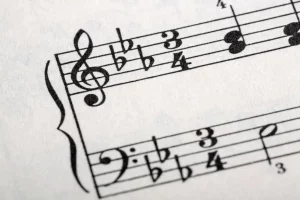Rhythm is the heartbeat of music, the element that guides our feet in dance and our hearts in song. It’s the structured sequence of sounds and silences in time, creating the pattern by which music moves and breathes. But within this structure lies a compelling force that adds complexity and spice to the rhythm: syncopation.
Syncopation occurs when a piece of music emphasizes unexpected beats in the measure. Instead of the regular, predictable beats that form the backbone of the rhythm, syncopated notes are thrust into the spotlight, creating a dynamic and often surprising musical experience. This rhythmic twist can make even the simplest melody feel fresh and invigorating.
In musical composition, syncopation isn’t just a technique; it’s a language that communicates mood, emotion, and attitude. It’s the playful skip in a jazz solo, the suspenseful pause in a classical score, and the driving force in a rock anthem. Syncopation in music challenges our expectations and keeps us engaged, eagerly anticipating the next surprise.
As we delve into the world of syncopation, we’ll discover its roots, its role across various genres, and how it continues to shape the evolution of modern music. Whether you’re a seasoned musician or a curious listener, understanding syncopation will deepen your appreciation for the artistry of rhythm.

The significance of syncopation in modern music
The roots of syncopation stretch deep into the annals of music history, finding its pulse in the early works of classical composers and the rich tapestry of African and Latin American rhythms. Over time, syncopated rhythm has evolved, becoming a cornerstone of modern music, shaping genres and thrilling listeners.
The historical journey of syncopation is a testament to its transformative power. In the Baroque period, composers like Bach used syncopation to create tension and release in their compositions. As music evolved, so did the use of syncopation, with the ragtime pianists of the early 20th century weaving it into the fabric of American music culture. This rhythmic innovation continued to flourish, giving birth to the irresistible grooves of jazz, the upbeat tempos of rock ‘n’ roll, and the pulsating beats of hip-hop.
But what is it about syncopation that so deeply affects us? The answer lies in its ability to surprise our neurological wiring. Our brains are pattern-seeking machines, and syncopation music plays with these patterns, often subverting expectations. This creates a pleasurable dopamine rush, similar to the feeling of solving a puzzle. It’s this psychological and emotional impact that makes syncopation an essential tool for musicians looking to captivate their audience.
Across different music genres, syncopation serves as a universal language of innovation and expression. In jazz, it’s the offbeat accents that give swing its swagger. In rock, it’s the unexpected drum fills that turn a song into an anthem. And in electronic dance music, it’s the dropped beats that fill dance floors. Syncopation’s versatility makes it a beloved element in the global music scene, transcending cultural and linguistic barriers.
The summary of the video
The video teaches the concept of syncopation, a rhythm technique that emphasizes normally unaccented beats. The demonstrator demonstrates this by clapping to a metronome in a 4/4 time signature, highlighting the difference between clapping on the beat and on the offbeat “ands.” She explains that syncopation is prevalent in various music genres, particularly those that make you want to dance, such as jazz, funk, and rap. In the video, George Gershwin’s “Novellette in Fourths” is used to illustrate syncopated rhythms in practice. The video is educational and interactive, encouraging viewers to practice and listen for syncopation in everyday music.
Exploring the varieties of syncopation
Syncopation takes many forms, each with its unique character and effect on the music. Its most common types are:
Suspension syncopation: delaying the beat
Suspension syncopation occurs when a piano note is held over from a weak beat to a strong beat. The delayed resolution of the note creates a sense of anticipation and tension, compelling the listener to wait for the beat to catch up.
Missed beat syncopation: skipping the expected
In missed beat syncopation, the musician intentionally omits a beat where the listener expects to hear one. This absence of sound can be as impactful as its presence, creating a rhythmic vacuum that draws attention and adds drama to the piece.
Even note syncopation: challenging the rhythmical norm
Even note syncopation disrupts the flow of a piece by accentuating notes where even beats would typically be unemphasized. This type of syncopation often features in funk and groove-oriented music, where it contributes to a song’s danceability.
Offbeat syncopation: emphasizing the unexpected
Perhaps the most recognized form, offbeat syncopation, places emphasis on the beats that fall between the expected strong beats. This emphasis on the “and” of a count (e.g., 1 and 2 and) injects energy and can often be found in the infectious rhythms of reggae and ska.
Each type of syncopation serves a different purpose and can be used for various effects, from subtle to striking. Musicians often employ these techniques to inject life into their compositions, to keep the audience on their toes, and to express a range of emotions through rhythm.

Mastering syncopation
For musicians, particularly those at the beginning of their journey, mastering syncopation is both a challenge and a milestone. Here are strategies and tools to help develop this skill:
Techniques for identifying syncopation in music
- Active listening: Study songs with notable syncopated rhythms. Listen repeatedly and tap along to internalize the offbeat accents.
- Score study: Look at piano sheet music and identify syncopated notes. They’re often tied over from weak to strong beats or placed on offbeats.
Strategies for practicing and incorporating syncopation
- Metronome practice: Use a metronome to maintain a steady beat while you play syncopated rhythms. Start slow and gradually increase the tempo.
- Isolation: Practice syncopated sections separately before integrating them into the rest of the piece.
- Imitation: Mimic the rhythms of syncopated music you admire. This can be a stepping stone to creating your own syncopated compositions.
Tools and exercises to develop syncopation skills
- Rhythm exercises: Clap or tap out syncopated rhythms before playing them on your instrument.
- Software and apps: Utilize music education apps like Skoove, which offer various high-quality online piano lessons.
- Collaboration: Play with other musicians. Syncopation often becomes clearer when you’re part of a rhythm section.
The unspoken language of syncopation
In the symphony of musical elements, syncopation acts as a subtle rebel, defying expectations and infusing songs with a unique sense of rhythm and flow.
Looking ahead, the future of syncopation in music is as promising as it is exciting. As musical genres continue to blend and evolve, syncopation will undoubtedly play a pivotal role in shaping the next wave of musical innovation.
Author of this blog post:

Eddie Bond is a multi-instrumentalist performer, composer, and music instructor currently based in Seattle, Washington USA. He has performed extensively in the US, Canada, Argentina, and China, released over 40 albums, and has over a decade experience working with music students of all ages and ability levels.














